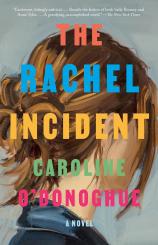The Rachel Incident
Review
The Rachel Incident
Updating the romantic comedy --- a genre in which wit surpasses sentiment --- is an enterprise that Jane Austen herself might have admired. Not that THE RACHEL INCIDENT is one of those Austen retellings (thank goodness). It is an original: madly clever, understatedly charming, and, though Irish, blessedly free of blarney.
Author Caroline O’Donoghue has a podcast called “Sentimental Garbage” (so we already know the ironic-yet-playful place she is coming from) and has written two earlier novels for adults (published only in the UK), as well as a YA fantasy trilogy. But this new title, centered on a young woman in Cork, where O’Donoghue attended university, seems more personal and perhaps more serious --- though not at all heavy. It’s a thoroughly delicious read.
The book’s modern ancestors, beloved of my now-ancient generation, include Helen Fielding’s iconic BRIDGET JONES’S DIARY and its married-with-kids equivalent, I DON’T KNOW HOW SHE DOES IT by Allison Pearson. A more recent favorite is ROMANTIC COMEDY (how meta can a title get?) by Curtis Sittenfeld, who has been a guest on O’Donoghue’s podcast. What all these have in common is voice --- fresh, wisecracking, sharply feminist, deeply vulnerable. It’s a winning combination, particularly with the added attraction of an Irish lilt and a slang vocabulary that was sometimes new to me: craic, for example, which, according to my trusty search engine, is “a term for news, gossip, fun, entertainment, and enjoyable conversation.”
"O’Donoghue is a bold, funny, down-and-dirty writer, but she can be wonderfully sensitive about difficult subjects... The main reason to read and love [the book] are Rachel and James, awesomely bright, incredibly loyal 20-somethings struggling to become adults."
There is all of the above in THE RACHEL INCIDENT. We meet our heroine in the present, when she is already an established journalist in London, married and seven months’ pregnant with her first child. But the plot is really one giant flashback to 2009. In fine romantic-comedy tradition, Rachel, who is 20, is not your standard skinny blonde. Almost six feet tall since the age of 14 and described by at least one other character as “chubby,” she is massively insecure yet seldom without male companionship. An avid reader and fan of antique things (she once put “cameo brooch” on her Christmas list), she is studying English literature and working in a bookstore to pay her tuition. (Her middle-class family --- her father is a dentist --- took a major hit in the financial crash. Her parents’ embarrassment and depression, and her gradual evolution from spoiled brat to someone who realizes “they had been people all along,” supply some of the most touching moments in the novel.)
Rachel has a giant crush on her Victorian Lit professor, Dr. Fred Byrne. “He was huge and passionate, and he was the only man under fifty in the English department.” He is also married, his wife a former student. Now you’re thinking it’s going to be one of those line-crossing academic entanglements. Nope. In the bookstore, Rachel makes (best) friends with a colleague, James Devlin, who is gay but closeted; they move in together (and now you’re thinking it’s going to be a retread of “Will and Grace”: not that --- or not entirely --- either). Shortly thereafter, she meets the enthralling but elusive Carey, with whom she becomes violently involved (“My attraction to him came on like food poisoning”). She suffers the tortures of hell about his “fundamental flakiness.” As James puts it, Carey “would walk over hot coals for you, but he won’t commit to lunch plans.”
And thus, with a mere four characters, we have not one, not two or three, but four excruciatingly awkward triangles: Rachel, James and Dr. Byrne (who turns out to be, as he puts it, “quite ambidextrous,” sexually speaking). Rachel, Carey and James (Carey is jealous of their intimacy). James, Dr. Byrne, and his wife, Deenie (who has no idea her husband isn’t straight). And Dr. Byrne, Deenie and Rachel, who is a sort of protégé of them both (Deenie, who works in publishing, employs her as a barely paid intern/assistant). You can imagine the high jinks and low jinks (including blackmail) that ensue.
O’Donoghue is a bold, funny, down-and-dirty writer, but she can be wonderfully sensitive about difficult subjects, such as the differences in background that occasionally get in the way of James and Rachel’s intense, hilarious rapport. James, originally English, is working-class, with a caring mother, an addict father, and a childhood episode of sexual abuse. He learned how to survive early, so he is “far more housebroken” than sheltered Rachel, who is “unusually stupid” about things like cleaning and laundry. (Okay, maybe there is a touch of “Will and Grace” after all.) Rachel’s family, though broke, belongs to the professional class. When James says, angrily, “The playing field is not level,” she resists the implication that she’s privileged. But later, after moving to London, she finds that he’s right: her accent, her manners, her literary frame of reference are significant assets.
However, when Rachel becomes pregnant by Carey, privilege can’t save her. She is like any other Irishwoman in 2010: Abortion is illegal and, since you need to travel to England to get one, economically out of reach for people without money; it is also guilt-inducing (even when you know better). Later, as a journalist, she relives the “traditional abortion arc: going to the airport alone, shuffling past the protestors at the clinic, feeling tender and awkward in the hostel, and then on the plane back.” She calls it “a fairy tale at its most savage.”
This couldn’t be more relevant, given that in the US today, women in many states must travel in order to get a procedure, and even their access to medication abortions is in jeopardy. In her acknowledgements, O’Donoghue writes, “A sad fact of this book is that it revolves around the access --- or lack thereof --- of reproductive healthcare” and urges readers to contribute to Planned Parenthood and other organizations.
Good for her. I wouldn’t say that the book “revolves” around this issue, though. While THE RACHEL INCIDENT is shrewd about gender politics, it is not really a message novel. The main reason to read and love it are Rachel and James, awesomely bright, incredibly loyal 20-somethings struggling to become adults.
My one criticism (besides the title, which is not even explained until the last page) is that it might be a bit too smooth and streaming-ready. “I feel like we’re in a soap,” Carey says. He has a point. The plot twists pile up in unlikely fashion, which somewhat undermines the more thoughtful bits. Pretty much everybody has a happy ending (sorry for the spoiler, but hey). Both main characters achieve Cinderella-style success in a few years: James as a senior producer/writer on an American talk show, Rachel as a writer in London. Of course, by this time these two have wormed their brilliant way into your heart, so you are thrilled for them!
I can hardly wait to see who's cast in the TV version of THE RACHEL INCIDENT (it's just been optioned by Universal). I’ll be watching. But please, change that title.
Reviewed by Katherine B. Weissman on July 1, 2023
The Rachel Incident
- Publication Date: May 28, 2024
- Genres: Fiction
- Paperback: 304 pages
- Publisher: Vintage
- ISBN-10: 0593469445
- ISBN-13: 9780593469446




